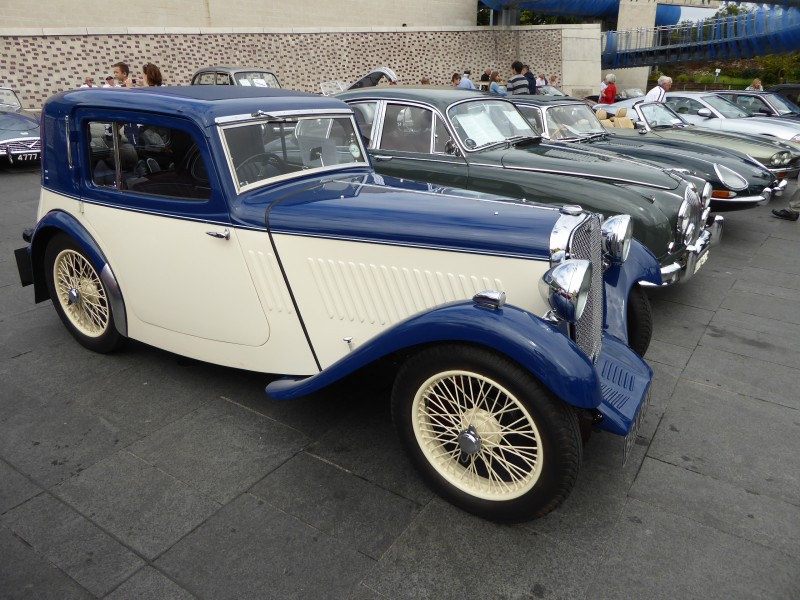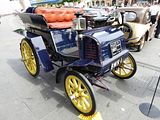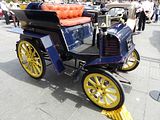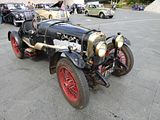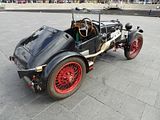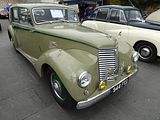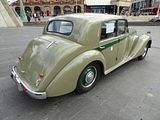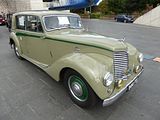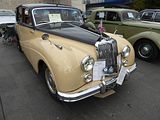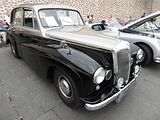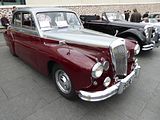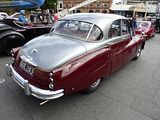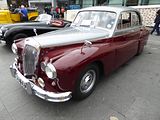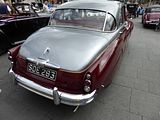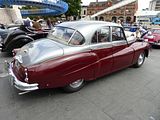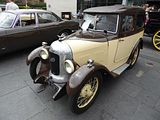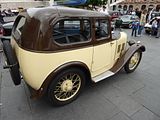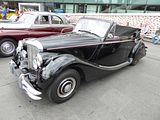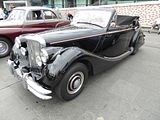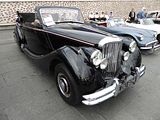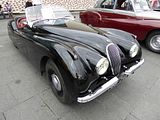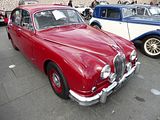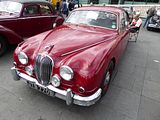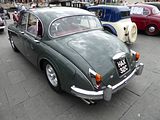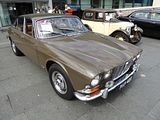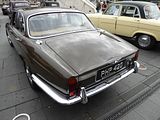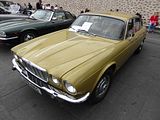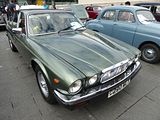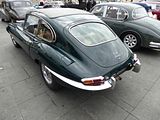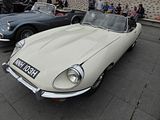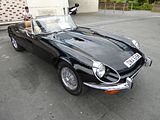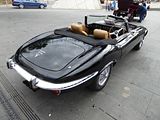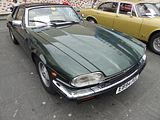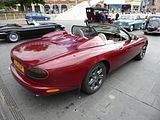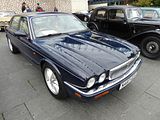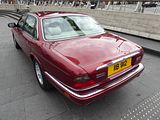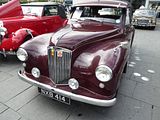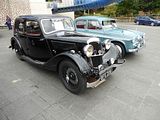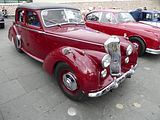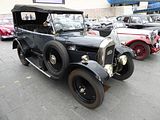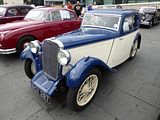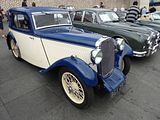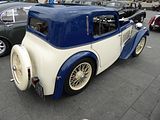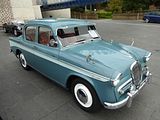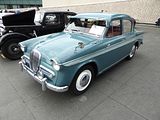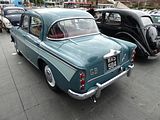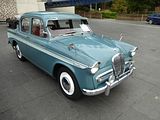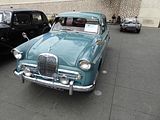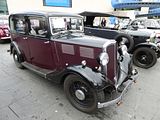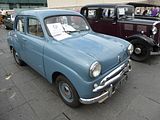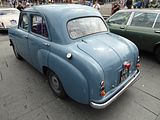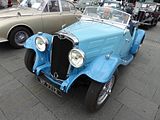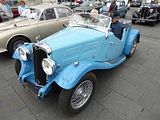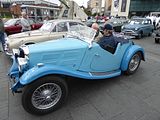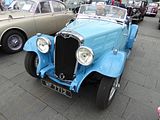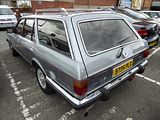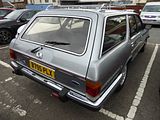Like many other people, I was disappointed to receive the news earlier this year that the rather enjoyable Coventry Festival of Motoring, held annually and in recent years at Stoneleigh Park would not be going ahead this year, as the costs of putting it on were too much for the budget of the city of Coventry to bear. Although all cars, no matter where they had been conceived or made had been welcome at this event, it did have a particular focus on the place which has always been at the heart of the British motor industry, and whilst the glory days with dozens of firms producing cars at various locations around Coventry are sadly long gone, the motor industry is still an important source of employment for the area, with the booming Jaguar-LandRover empire undertaking research and development at Whitley and production at nearby Solihull. Although funded by the City Council, the event had been organised by the Coventry Motoring Museum, and as a softening of the blow, the same email announcing the demise of the Festival did presage something planned to take place in the city the weekend before, which they called “Made in Coventry”. The idea was to gather together as many different cars and marques as possible, all of which had their origins in the city, and to display them on the large forecourt in front of the museum. It sounded interesting, and as it was en route to my destination for the following day, MITCAR, I decided to stop by and have a look. I arrived just after lunch, and sure enough, there were lots of cars parked up, as you will see from this report. More careful study of the event details would have told me that this was not the only location I should have visited, though, as when I went online to see if I had missed anything, I found that some of the marques I would have expected to see represented in quantity, such as Triumph, had indeed been in the event, but at other locations in the city and that there had been an assembly out at Stoneleigh Park earlier in the day. A total of 93 cars had taken part, along with the Lord Mayor, Miss England 2015, Miss Humber 1958 who was seen with the first car she bought, the Ladies of Coombe Abbey and even Santa! Moral of the story: read the event material properly! Even so, there were some splendid cars that I did see, and present here for your to enjoy as well.
THE OLDEST CAR OF THE DAY
This 1901 Godiva, which was wheeled from its usual abode of inside the museum outside into the fresh air, was made by Payne and Bates in 1901. Walter Payne had begun a business in Coventry in 1890 as an Engine Maker, funded largely by George Bates. Known as the Godiva Engineering Company, by 1895, Payne had developed what is thought to have been one of the first petrol engines in Coventry, at a time when motorised transport was becoming ever-more developed on the continent.. In around 1898, Walter Payne, together with his brothers and Henry Bates, developed a car based on the Benz model, not long after the Daimler Company had begun mass marketing cars in Coventry. By 1900 they had progressed to assemble both a car and motorcycle known as the ‘Godiva’ under the guise of Payne & Bates Ltd. The first model featured a 2 cylinder 9 hp engine and a number of 4 cylinder models followed soon thereafter, the ‘Shamrock’ and ‘Stonebow’, with power ranging from 7 to 25 hp, and supposed capable of speeds up to 40 mph, but all these projects were short-lived after the tragic death of George Bates in 1902 in a car accident while being driven by his son. Payne kept an engineering concern going until 1934, but no more cars were produced. The car seen here has its 1000cc engine at the back, which is connected to the rear wheels by belts and chains. The body is made of wood and its style is more like a horse and cart than a motorcar, in fact this type of car was called a ‘Horseless Carriage.’ As Payne and Bates did not make many cars, it is thought that this may be only one of its kind that has survived to this day. It was bought by the Museum in 1964.
ALVIS
Alvis began making cars at Holyhead Road in 1919. T. G. John (1880-1944) had been the works manager at the Siddeley-Deasy Motor Company before establishing the Alvis Motor Company. Alvis soon found a reputation for making quality sports and touring models, particularly during the 1920s and 1930s including the 14/40, the 12/50 sports, the ‘Silver Eagle’, the ‘Crested Eagle’ and the ‘Speed’ series. In 1920 they became the first British car manufacturers to offer a front-wheel drive model. During WWII they became more and more active in military projects, and in 1965 were taken over by the Rover Company. Alvis quickly became associated with the production of high quality military vehicles, building their last cars in 1967. Alvis continued, though, and remained based in Coventry until 1998 when the main operations moved to Telford. The original works on Holyhead Road have been demolished and the site now forms a retail park aptly called ‘Alvis’.
The only Alvis model in the display, at least by the time I arrived, as this, the 1927 ex-Foxlee 12/50 Alvis Special. The 12/50 was introduced in 1923 and went through a series of versions, with the last ones being made in 1932. A range of factory bodies (made by Carbodies and Cross & Ellis) could be specified in two- or four-seat form, either open or closed. The first models were designated SA and SB and had a 1496 cc 4-cylinder overhead valve engine in a chassis with a wheelbase of 108.5 in for the SA and 112.5 in for the SB. The engines of these early cars were carried in a subframe bolted to the relatively slender ladder chassis. The SA usually carried two-seat bodywork; often the classic so-called “duck’s back” style named after its pointed rear end, which was said to resemble that of a duck. The SA and SB 12/50s were built with brakes on the rear wheels only. All the 12/50s had a four speed non-synchromesh gearbox with right hand change. The SC arrived in Autumn 1924 for the 1925 model year with a larger 1598 cc engine (unless the 1496 cc unit was specified for sporting use) and, like all the remaining cars, the longer chassis. Front wheel brakes were offered as an option on this model. A new stronger chassis was designed and used for the TE of 1926, which had its engine, now built around a redesigned crankcase enlarged again to 1645 cc, and the TF of the same year which retained the smaller 1496 cc version. A single-plate clutch replaced the previous cone type, and for these and all subsequent 12/50s the engine was bolted directly to the chassis, dispensing with the subframe of previous models. From the TE and TF models onwards four-wheel brakes were fitted as standard. The TE and TF were superseded in 1927 by the TG and SD with large and small engine respectively. The TG was the standard ‘touring’ model, while the SD – powered by the 1496cc engine, now fitted with a large-port cylinder head – satisfied the needs of the sporting motorist. Also available in this year was the TH, which had the gearbox and rear axle ratios of the ‘touring’ TG, but the sub-1500cc engine of the SD. The TG and SD models were available until 1929. The 12/50 was withdrawn between 1929 and 1930 when the company decided that the future lay with the front-wheel drive FD and FE models, but when these did not reach the hoped for volumes a final version of the 12/50 was announced as the 1645 cc 1931 TJ continuing until 1932. The TJ is referred to by Alvis historians as being from the ‘revival period’, and it differs from its predecessor in a number of ways, notably coil instead of magneto ignition, deep chromed radiator shell, and rear petrol tank in place of the scuttle-mounted tank on most older 12/50s. Survival rate of the 12/50 cars is good, and they are popular classics at VSCC events.
ARMSTRONG SIDDELEY
Although largely forgotten now, and a marque that few youngsters have even heard of, Armstrong Siddeley, who made cars from 1919 to 1960 in Coventry were once well known and respected for the quality of the products they produced. It was John Davenport Siddeley (1866-1956) who in 1902 established the Siddeley Autocar Company at Garfield Road, Coventry, initially as importers of Peugeot cars. After a brief stint working for the Wolseley Tool & Motor Car Company, in 1909, he became Lord Kenilworth and Managing Director of the Deasy Motor Company. By 1911, the business was reformed as the Siddeley-Deasy Motor Manufacturing Company at Parkside, Coventry. Armstrong-Siddeley Motors Ltd began soon after the conclusion of WWI in 1919 after a merger between the Armstrong-Whitworth and Siddeley-Deasy companies. Recognized for building cars with large ‘V’ radiators, the company were reportedly the very first to introduce a completely new post-War model. Some of the names for these vehicles were clearly inspired by the aeroplanes used during the War including the ‘Hurricane’ and the ‘Lancaster’. Production lasted until 1960 in Coventry, with the ‘Star Sapphire’ being the last model made. At this point, the parent company Hawker-Siddeley merged with the Bristol Company.
The Whitley was a large sports saloon, a version of the 16/18 hp series, made between 1946 and 1954. The Whitley was the last of the range to enter production, first appearing in 1949. It only used the larger 2309 cc overhead valve engine with a tax rating of 18hp that had first appeared on export versions of the Tempest coupled with a choice of synchromesh or pre-selector gearbox. The front suspension was independent using torsion bars, while at the rear was a live axle and leaf springs. A Girling hydro-mechanical braking system was fitted, with the front drums hydraulically operated, while those at the rear were cable. A variety of body styles were made, of which the most common are the 4 or 6 light saloons, but limousines were also made on a long-wheelbase chassis from 1950 to 1952. The Utility Coupe and Station Coupe were pick up versions made for the export market and in particular for Australia. The former had a conventional front seat only and the latter had an extended cabin with a small additional seat at the rear. 4321 examples of the Whitley were made in a 5 year period.
Replacement for the Whitley was the Sapphire. First seen in 1952, this extended into quite a range of different models over the next 8 years. The first model to bear the Sapphire name was the 346, introduced late in 1952 for sale in 1953 and continuing until 1958. It had a six-cylinder 3,435 cc engine with hemi-spherical combustion chambers and could have optional twin Stromberg carburettors, a £25 extra, which increased the output from 125 to 150 bhp giving a top speed in excess of 100 mph. The front suspension was independent coil springs with a rigid axle and leaf springs at the rear. The body was available as a four- or six-light (two or three windows on each side) at the same cost and with either a bench or individual front seats. The seats were finished in leather, with the dashboard and door-cappings in walnut veneer. A heater was standard. It was introduced with the choice of a Wilson electrically-controlled finger-tip four-speed pre-selector gearbox as a £30 option, or four-speed synchromesh gearbox. It became available with a Rolls-Royce four speed automatic transmission with the introduction of the Mark II in 1954. A long-wheelbase model was launched in 1955 as a limousine version which had the pre-selector gearbox as standard, however, there was an optional four-speed manual column-change gearbox available. 7,697 of the 346s were produced. Next to appear were the cheaper Sapphire 234 and 236 cars. They were identical in appearance but sold with different engines having different performance characteristics. The 234 could be purchased with wire wheels as an optional extra. The 234 was produced from 1955 to 1958 and used a four-cylinder 2,290 cc version of the 346 engine. The transmission was a manual four-speed gearbox with optional overdrive. It was a genuine 100 mph car intended for the man who liked high performance, and 803 of them were produced. The 236 was made between 1955 and 1957 and used the six-cylinder 2,310 cc engine previously seen in the Whitley. A conventional manual gearbox was available but many were fitted with a Lockheed Manumatic “clutchless” transmission. Overdrive was an option on either transmission. This car with an 85 mph maximum was intended to be a quiet, flexible, easy-to-drive saloon, and 603 were produced. In 1958, Armstrong-Siddeley showed what would turn out to be their final model, and the car seen here, the Star Sapphire. Little changed externally from the 346, the radiator grille no longer rose to the top of the bonnet, and there were other detailed changes, including concealed door hinges and the fact that the front doors now hinged at their leading edge. The six-cylinder engine was enlarged more than 16% to 3,990 cc with larger twin Stromberg carburettors as standard and power output increased to 165 bhp Perhaps more important was an increase of nearly 30% in torque at 50 mph. Big end and main bearings were now made of lead indium and a vibration damper fitted to the nose of the crankshaft. The compression ratio was raised to 7.5 to 1. The car could now lap the Lindley high speed track at 104 mph. Various suspension modifications had been carried out. Servo-assisted 12″ Girling disc brakes were now installed on the front wheels and Burman recirculating ball power steering was standardised with a turning circle reduced by 4’6″. A BorgWarner type DG automatic gearbox was fitted which incorporated a lever on the fascia to hold intermediate gear at 35, 45, 55, and 65 mph. There was an independent heater for the rear passengers and demisting slots for the rear window. All features were standard, the provision of alternatives being believed to lead to an unsatisfactory compromise. This was a high quality car, intended to rival Daimler, Jaguar and even Rolls Royce products of the era, and indeed the Star Sapphire won the £4,000 four-door coachwork class at the 1958 Earls Court Motor Show ahead of a Princess limousine and a Jaguar Mark IX. When production ceased in 1960, 902 saloons had been made, as well as 77 long-wheelbase cars, 73 of which were built as limousines (including 2 prototypes). The limousine version was made in 1960 only and had a single-carburettor engine and manual gearbox (the automatic gearbox was fitted to 12 examples). The remaining 4 chassis were used for 3 hearses and an ambulance, meaning a total of 980 Star Sapphires were produced.
DAIMLER
The Daimler Motor Company were one of the earliest of the motorcar manufacturers based in Coventry. Harry J. Lawson (1852-1925) established the British Motor Syndicate in 1895 after securing foreign patent rights from the renowned motor consultant, Frederick Simms. After looking in both Birmingham and Cheltenham for a suitable factory to manufacture motors, Lawson finally chose Coventry. He knew Coventry well, having first moved there from Brighton in 1878 to work for the cycle makers Haynes and Jefferis, and later, Rudge. His search for a factory ended when he opted to buy a disused cotton mill in the Draper’s Field area of the Coventry, and had it transformed it into the famous ‘Motor Mills’. In 1896 he established both the Daimler Motor Company and the Great Horseless Carriage Company on the site. The Daimler Company was offered for public subscription in February 1896 with a capital of £100,000 in £10 shares. As well as Lawson, another company Director of Daimler was Henry Sturmey, the editor of the Coventry based “The Autocar” magazine through which all Lawson-controlled motor companies received very favourable press. Initially, prototype cars were developed, but by 1897 the production of Daimler models was well under way – the first company in Britain to mass produce motorcars. To prove the motive power, strength and reliability of new Daimler cars, in 1897 Sturmey had one shipped to John o’ Groats, and then personally drove it to Lands End, covering over 1,000 miles. Daimler steadily became famous for making commercial vehicles, luxurious cars and limousines, often the first choice of royalty, the rich and famous. The business became a part of BSA in 1910, continuing production along similar lines until the conclusion of WWI when most 4-cylinder cars were dropped. The 1920s saw the introduction of high-end models such as the Royal favourite, the 12-cylinder 7.1 litre ‘Double Six’, and by 1927 Daimler were offering no less than 23 separate models. Four years later Daimler acquired the Lanchester name which saw the manufacture of slightly less luxurious models than their own. After WW2 more limousine cars were developed including the ‘Conquest’, and the automatic ‘Majestic’ by 1958. Nonetheless, though, by the mid 1950s, it was clear that Daimler was in trouble. As an example, the Conquest Roadster had started out priced close to the Jaguar XK120 at £1673, by the time the New Drophead was released the price was £280 more than an XK140. While Jaguars became less expensive, the hand built Daimlers had escalated in price. Jaguars sold in large numbers, and Daimlers sold in small numbers with frequent model changes. Daimler’s problems became increasingly obvious, and in 1960, Daimler was bought by Jaguar, who wanted the additional factory space. Daimlers after this time, with the exception of the DS450 Limousine, soon became little more than a high class version of a Jaguar model. Nonetheless, Jaguar continued to build the luxury Daimlers in Coventry until July 2005.
Oldest Daimler on show at this event was this, a 1911 car and a very rare example of a Daimler with a 12hp Knight sleeve valve engine. This engine was developed by the American engineer Charles Knight, and the Daimler Company adopted it in 1910. It was quieter than other engines of the period because it replaced the noisy poppet valves with a sleeve valve fitted between the piston and the cylinder wall. This car would have cost £375 when new, whereas a 57hp Daimler would have cost £900 for the chassis only, with the bodywork being extra. It was overhauled and returned to its original specifications by Daimler apprentices in 1944 and lives in the Museum.
The Conquest saloon was released to the public in 1953 as a replacement for the Daimler Consort, but was shorter and lighter, with better performance. The Daimler Conquest was meant to be an affordable Daimler, priced at £1066, and it is widely believed that its name derives from this. The whole car appears to have been developed within four months of Bernard Docker, then managing director of BSA, taking on the additional responsibility of managing director of Daimler in January 1953. Presented as a new car, the 75 hp Conquest saloon’s chassis and running gear had originated in the 1950 Lanchester Fourteen. Lanchester had been a subsidiary of Daimler for 20 years by this time,and the Fourteen still sported a coachbuilt steel body on a timber frame, but this model had been updated to the Leda with an all-steel body, and apart from the grille, the Conquest was identical in appearance to the Leda. It was built by another BSA subsidiary, ‘Carbodies’. Although this was designed to a more affordable Daimler, there were plenty of the features that buyers of the marque expected to see. The Conquest had a large cruciform chassis with a double wishbone front suspension, with laminated torsion bars, telescopic dampers, and an anti-roll bar, while the rear suspension used leaf springs with telescopic dampers. There was automatic chassis lubrication to 21 points, using a pump controlled by exhaust heat. Cam and peg steering was used, and Girling hydro-mechanical brakes. The model still had a luxurious, well-appointed traditional wood-grain and leather interiors. Later in 1953, the Saloon was joined by the ope topped 2-seater Conquest Roadster, which first appeared at the Earls Court Motor Show, though it was not available to buy until into 1954. It featured a tuned engine later known as the Century engine. The Daimler Conquest Century, released in 1954 was the best seller of the range with 4818 of them produced. A hundred-horsepower and, presumably downhill, a hundred miles an hour, helped generate the model’s name, the Century. In January 1955, a revision to the Conquest created four inches more leg-space for rear-seat passengers. In addition doors now opened wider and there were “further interior embellishments”. The Conquest Roadster was dropped from production in 1955. The dropheads had outsold them by over 3:1. Then a new drophead 4-seater and a drophead coupé version of the 2-seater Roadster were introduced at the 1955 Motor Show. This Mark II Conquest Roadster drophead coupé had a sideways-facing single rear seat, making the car a 2- or 3-seater and with wind-up side windows in place of the clip-on side-curtains of the continuing Mark II open 2-seater Conquest Roadster. Two of the roadsters, at least, were coach-built as fixed head coupés. However at this time many very small businesses indeed offered low-cost glass-fibre-reinforced removable tops for all brands of open sports-cars. There is one fibreglass new drophead, and one fibreglass fixed head coupé (with a Hillman Minx Californian three piece rear window!!) One-offs seem to have been mostly done on Roadster allocated chassis, so there may have been even fewer roadsters built than officially indicated. In October 1956, Conquest Century buyers were offered the choice of an automatic transmission or the traditional preselector system, these latter fading away as modern automatic transmissions took their place. Currency restrictions had meant that until Borg-Warner built a British plant automatic transmissions were only available on export cars. The price of the Conquest was reduced in April 1956 by 12% and again in September 1956 by between 7% and 16%, but it was not enough. as the economic conditions worsened following the Suez Crisis later that year. Production of the Conquest ceased in 1958.
The Daimler Regency series were larger cars than the Conquest models. First seen at the Paris and British Motor Shows in the autumn of 1851, the chassis of the new car was from the 2½-litre Eighteen Consort, fitted with a new 3-litre engine design derived from the Lanchester Fourteen. The usual Daimler Fluid Flywheel coupled the engine and its Wilson pre-selector 4-speed gearbox. The shape of the standard Barker saloon body closely resembled the much smaller Lanchester Fourteen which had been launched the previous year. It was joined in 1952 by an Empress II saloon and limousine and convertible all with razor-edge styling by Hooper, but only 52 examples of the first series Regency cars were produced as demand collapsed in 1952 thanks to the overall economic situation. A much revised Regency DF304, labelled Mark II was announced in October 1954. The new more flowing body was slightly longer with a much longer boot and wings and was lower-set. It could now be purchased with a 3½-litre or 4½-litre engine. Again there was a Hooper version, the Empress IIa and III and there was also the Sportsman four-light saloon with coachwork by Mulliners of Birmingham, which had a three-piece wrap-around rear window and extra interior luxury features and was initially only available with the 4½-litre engine. Just 23 of these Sportsmans were built, and it is believed that only 3 survive, of which this is one.
By the mid 1950s, Daimler were in trouble. The cars were expensive and just not selling. New models were seen as a potential way of changing things around, so shortly after being appointed Managing Director of BSA’s Automotive Division in 1956, Edward Turner was asked to design a saloon car powered by a new V8 engine. The engine drawings were finalised by March 1958 but the saloon prototype, project number DN250, was not available for examination by the committee formed in 1958 to report on the feasibility of the V8 cars. The committee’s evaluation centred on the prototypes being tested at the time, which were for the SP250 sports car project. according to the feasibility study conducted by the committee, the SP250 would generate a profit of more than £700,000 based on a projection of 1,500 cars being sold in the first year of production and 3,000 cars per year for the second and third years of production. Two-thirds of the sales of the car were expected to be in the United States. The study also determined that the body should be made from fibreglass, with shorter time to the beginning of production, tooling costs of £16,000 as opposed to £120,000 for steel bodies, and lower cost to change the styling. That meant that the car was able to be launched at the 1959 New York Show, christened the Daimler Dart. Chrysler, whose Dodge division owned the trademark for the “Dart” model name, ordered Daimler to change the name under threat of legal action. With little time to come up with a new name, Daimler used the project number, SP250, as the model number. The car certainly looked quite unlike previous Daimlers, but whether that was a good thing is less clear as the SP250 won “The Ugliest Car” via vote at that 1959 show. That was not the only problem with the car, either. The original version, later called the A-spec, could reach a speed of 120 mph, but the chassis, a “14-gauge ladder frame with cruciform bracing” based on the Triumph TR3,flexed so much that doors occasionally came open, marring its reputation. The car featured the smaller of the two hemi-head V8 engines which Edward Turner had designed. 2547cc in capacity, it was a V8, iron block, OHV unit, with a single central camshaft operated valves through short pushrods with double heavy-duty valve springs, aluminium alloy hemispherical cylinder heads, and twin SU carburettors which meant it put out 140 bhp.The manual gearbox, the first of the type used by Daimler since they started using the pre-selector type across their range in the 1930s,, was reverse-engineered from the Standard gearbox used in the Triumph TR3A. Early examples of the car were not particularly reliable. Sales were slow, initially, and Daimlers problems were compounded when, not long after they had been acquired by Jaguar, an in-house rival in the form of the E Type arrived on the scene. New bosses at Jaguar did not kill off the SP250, though, but they were immediately concerned about the chassis flex. They brought out the B-spec. version with extra outriggers on the chassis and a strengthening hoop between the A-posts. There were also other detail improvements, including an adjustable steering column. Bumpers had originally been an optional extra. With the basic specification not including full bumpers, the A-spec. cars have two short, chromium-plated ‘whiskers’ on the body on either side of the front grille and two short, vertical bumpers, or “overriders” at the rear, which were not included if the rear bumper was optioned. B-spec. and the later C-spec. cars do not have the ‘whiskers’ that A-spec. have and some do not have the optional front bumper, so there is very little front protection for these cars. A planned Coupe version of the car, the DP250 never got beyond the prototype phase, and Ogle Design’s proposal for a Coupe version was not taken up, the styling for that concept ending up forming the Reliant Scimitar GT. The SP250 ended production in 1964. Just 2,654 SP250s were produced in five years of production, far short of the projection of 3,000 per year by the second year of production. Jaguar did built a prototype replacement under project number SP252 with a neater body style but decided not to proceed with production, as they figured that the cost to build the SP252 would have been greater than that of Jaguar’s popular and more expensive E-Type, thereby creating internal competition from a product with no practical profit margin and with uncertain market acceptance. The 2½ litre V8 engine used in the SP250 was used by Jaguar to power the smaller saloon Daimler had wanted from the start. This was basically a Jaguar Mark 2 with the V8 engine from the SP250 modified to fit in the Mark 2 engine bay and revised interior, trim, and suspension settings. Sold between 1962 and 1967 as the Daimler 2½-litre V8 and from 1967 to 1969 as the Daimler V8-250,the Daimler car with the highest production figures. These days, surviving SP250s are viewed rather more positively than they were when new, and a certain Quentin Willson, who has owned one for many years, is particularly positive about the car’s merits.
JAGUAR
The origins of the Jaguar Company go back to 1922 when William Lyons and William Walmsley set up the Swallow Sidecar Co. in Blackpool. Before long they also began making motor bodies and so in 1928 the entire business relocated to part of the former White and Poppe factory in Coventry to be at the heart of the motor industry. As the Swallow Coachbuilding Co., in 1931 they began manufacturing ‘SS’ cars as well as bodies, becoming SS Cars Ltd. in 1934. These forerunners consisted mainly of beautifully designed six-cylinder sports tourers and saloons. The outbreak of WWII meant that much production was adapted to that of aircraft and other munitions work along with many similar Coventry operations. In 1945, the business was reformed as Jaguar Cars Ltd., where a steady stream of 1.5 litre saloons were introduced. In 1951 the company moved all plant and machinery at great expense to Brown’s Lane, a former Daimler shadow-factory. Here they commenced the production of elegantly-styled sports cars and luxury saloons of which they became famous. Jaguar added the Daimler name to their range in 1960 and continued to make high-quality prestigious cars in Coventry until 2005, before moving production to Solihull and Liverpool. Head office, and centre for research and development remains at Whitley, just outside the city.
A number of the Jaguars that were displayed had been brought together by the Jaguar-Daimler Heritage Trust, and several of their members were on hand to talk about the cars. Oldest here was an example of the very first model that the fledgling Swallow Sidecar Company produced. When Lyons and Walmsley decided to move into car production, the first model that they looked to as a base for their ideas was the Austin 7, a popular and inexpensive vehicle. For their show car, Swallow’s Bolton, Lancashire agent had persuaded a dealer to supply him under-the-counter (coachbuilders required Austin’s prior approval or warranties might be voided) with an Austin 7 chassis. Lyons, with a sketch of what he wanted, commissioned Cyril Holland, a coachbuilder by trade, to create a distinctive, open two seater body. Holland gave it a detachable hardtop with a characteristic back window. The result was announced to public in May 1927, the Austin Seven Swallow. Austin gave their approval to the Swallow coachwork though adjustments were needed, as the wings kept falling onto the tyres and the cycle type were dispensed with in favour of the more usual shape. In that form it was taken to London and shown to Henlys — Bert (Herbert Gerald) Henly and Frank Hough — who ordered 500 both two-seaters and saloons. Priced at only £175, the Swallow, with its brightly coloured two-tone bodywork and a style that imitated the more expensive cars of the time, proved popular in the prosperous late twenties and in the following depression. Soon after, a saloon version was produced: the Austin Seven Swallow Saloon, and the model seen here is one of these, dating from 1931.
This is a Mark V 3.5 litre Drophead. The origin of the Mark V name is somewhat mysterious as there had been no Mk I to IV Jaguars and the MK IV designation was only given to its predecessor after the launch of the Mk V. It was perhaps a nod to Bentley who built 11 advanced Mark V saloons in 1939, resumed with the Mark VI in 1946-52 and who then dropped the “Mark” naming thereafter, while Jaguars continued with the Mark VII to X. The Mark V was launched at the 1948 London Motor Show at the same time as the XK120, with which it shared a stand. However, the Mark V vastly outsold the XK120 by roughly 5,000 cars per year as compared to 2,000 cars per year for the XK120. While the XK120 had a new overhead-camshaft XK engine, the Mark V retained the 1936 driveline including the “Jaguar” overhead-valve pushrod straight-6, 2½ litre and 3½ litre units for which the company was renamed after the war. No 1½ litre version was offered. Claimed power output in this application was 104 bhp for the 2664 cc Mark V and 126 bhp for its more popular 3486 cc sibling. The chassis was new with independent front suspension by double wishbones and torsion bar, an arrangement that would be used by Jaguar for many future vehicles. It also had hydraulic brakes, which Jaguar had been slow to adopt compared to other manufacturers, and an all pressed steel body. The styling of the car followed prewar SS-Jaguar lines with upright chrome grille and the leaping Jaguar radiator cap mascot became available as an option. There is a distinct hint of the recently modernised Bentley look in the style of the front grille. The wheels were 16-inch steel-disc type, significantly smaller than the 18-inch ones on the MK IV. From the side, a distinctive styling touch was a “tuck in” curve at the base of the rear window following the curved profile of the side glass. Rear-wheel spats (fender skirts) were standard. Production ran through to 1951, and although the majority of Mark Vs were Saloon models, around 1000 Drophead Coupés were made as well, and these are now highly sought after.
Also highly sought after, of course, is the XK120. Launched in open two-seater form at the 1948 London Motor Show, the car was a testbed and show car for the new Jaguar XK engine. The display car was the first prototype, chassis number 670001. It looked almost identical to the production cars except that the straight outer pillars of its windscreen would be curved on the production version. The roadster caused a sensation, which persuaded Jaguar founder and design boss William Lyons to put it into production. Beginning in 1948, the first 242 cars wore wood-framed open 2-seater bodies with aluminium panels. Production switched to the 112 lb heavier all-steel in early 1950. The “120” in the name referred to the aluminium car’s 120 mph top speed, which was faster with the windscreen removed. This made it the world’s fastest production car at the time of its launch. Indeed, on 30 May 1949, on the empty Ostend-Jabbeke motorway in Belgium, a prototype XK120 timed by the officials of the Royal Automobile Club of Belgium achieved an average of runs in opposing directions of 132.6 mph with the windscreen replaced by just one small aeroscreen and a catalogued alternative top gear ratio, and 135 mph with a passenger-side tonneau cover in place. In 1950 and 1951, at a banked oval track in France, XK120 roadsters averaged over 100 mph for 24 hours and over 130 mph for an hour, and in 1952 a fixed-head coupé took numerous world records for speed and distance when it averaged 100 mph for a week. Roadsters were also successful in racing and rallying. The first production roadster, chassis number 670003, was delivered to Clark Gable in 1949. The XK120 was ultimately available in two open versions, first as an open 2-seater described in the US market as the roadster (and designated OTS, for open two-seater, in America), and from 1953 as a drophead coupé (DHC); as well as a closed, or fixed head coupé (FHC) from 1951. A smaller-engined version with 2-litres and 4 cylinders, intended for the UK market was cancelled prior to production.
One of the most loved Jaguars of all time, both when it was new, and still now, is the Mark 2 saloon. Many will tell you that it is not the 3 Series BMW that “invented” the “compact sports saloon” car class, but this model, which dates back to 1959. A thorough revision of the small Jaguar saloon that had joined the range in 1955, the Mark 2 was notable in that it was the first car to use the Arabic numeral in its name, as opposed to the Roman numerals of the larger Jaguar models. At launch, the earlier model which had hitherto been known by its engine size was christened the Mark 1. Although clearly based on that car, the updated car looked significantly different, with an increase of 18% in cabin glass area greatly improving visibility. The car was re-engineered above the waistline. Slender front pillars allowed a wider windscreen and the rear window almost wrapped around to the enlarged side windows now with the familiar Jaguar D-shape above the back door and fully chromed frames for all the side windows. The radiator grille was amended and larger side, tail and fog lamps repositioned. Inside a new heating system was fitted and ducted to the rear compartment (although still notoriously ineffective). There was an improved instrument layout that became standard for all Jaguar cars until the XJ Series II of 1973. As well as the familiar 2.4 and 3.4 litre engines, what made this car particularly special was that it was also offered with the potent 220 bhp 3.8 litre unit that was fitted to the XK150 and which would later see service in the E Type. This gave the car a 0 – 60 time of around 8.5 seconds and a top speed of 125 mph. No wonder that the Mark 2 became popular as a get-away car for the criminal fraternity, and to keep up with and catch them, many police forces bought the car as well. With revised suspension and standard four wheel disc brakes, the car was effective on the track, taking plenty of class wins when new, and it is still popular in historic racing circles today. The quickest and most successful private entries came from John Coombs, a man with significant race experience who operated a large Jaguar dealership in Guildford. Coombs would undertake modifications to meet the demands of his customers, so not all the cars that he worked on are the same. Jaguar replaced the Mark 2 with simplified and slightly more cheaply finished 240 and 340 models, as an interim measure until an all-new model was ready to take over from them. The 3.8 litre disappeared from the range at this time, but in the 7 years it had been in production, it had been the best seller of the range, with around 30,000 cars produced, as compared to 28,666 of the 3.4 litre and 25,741 of the 2.4 litre model. Seen here were a couple of examples of the 3.4 model.
The Jaguar XJ6, launched in the autumn of 1968, was intended to replace all four of the saloon car ranges that Jaguar had been offering. Available initially with a choice of 2.8 and 4.2 litre XK engines, these cars wowed the press and the public just as much as many of their predecessors had done, both for their excellence and the fact that they were priced well below their competitors. It was not long before there was a long waiting list. As if this was not enough, the new V12 engine which had first been seen in the Series 3 Jaguar E Type was slotted under the bonnet of the cars in Spring 1972, creating one of the fastest and most refined saloons available in the world. At the time, the fact that it would only average around 11 mpg was not an issue, but within 18 months, and the onset of the Yom Kippur war and the resultant fuel crisis of late 1973, suddenly these cars – desirable as they were – became rather harder to sell. A Series 2 model was launched in the autumn of 1973, with new front end styling and bumper height set to meet the requirements of the critical US market. A very elegant Coupe model was added to the range, though it took until 1975 before these cars entered production, and they were only made for 2 years, and fewer than 10,000 were made. A third update came in March 1979, with a raised rear roofline intended to give more headroom to those who sat in the back, and fresh detailing of the lights and large impact-absorbing bumpers. In this form, the car was produced until late 1986 when the much delayed XJ40 took over. There were three models here, one from each Series. The earliest of them, a well known car that belongs to Jaguar Heritage was Sir William Lyons’ personal car. It was the 370th XJ6 made. It was taken out of service in 1976, and restored some 10 years later. Joining it was a Series 2 4.2 and a Series 3 XJ12.
Needing no introduction, is the famous E Type, the car considered by many to be Sir William Lyons’ greatest achievement. Not only did this car have stop-you-in-your-tracks gorgeous styling, but it had explosive performance (even if the 150 mph that was achieved in The Autocar’s Road Test is now known to have been with a little “help”), but it was the price that amazed people more than anything else. Whilst out of reach for most people, who could barely afford any new car, it was massively cheaper than contemporary Aston Martins and Ferraris, its market rivals. It was not perfect, though, and over the coming years, Jaguar made constant improvements. A 2+2 model joined the initial range of Roadster and Coupe, and more powerful and larger engines came when the 3.8 litre was enlarged to 4.2 litres, before more significant styling changes came with the 1967 Series 2 and the 1971 Series 3, where new front end treatments and lights were a consequence of legislative demands of the E Type’s most important market, America. There were examples of all three Series here, unsurprisingly: a Series 1 2+2, a Series 2 Roadster, and a V12 Series 3, one of the final 50 cars that were sold in 1975.
Successor to the E Type was the XJ-S, launched in September 1975, and to a not universally approving public. This was a very different sort of sporting Jaguar, more boulevard cruiser than sports car, even though the car had plenty of appeal with its smooth V12 engine which gave it genuine 150 mph performance. Press reports were favourable, but a thirsty V12 and a car with inconsistent build quality and styling that not everyone warmed to meant that sales were slow, and they got slower as the decade passed, leading questions to be asked as to whether the car should continue. As well as sorting the saloon models, Jaguar’s Chairman, John Egan, put in place a program to improve the XJ-S as well, which also benefitted from the HE engine in early 1981. A Cabrio model and the option of the new 3.6 litre 6 cylinder engine from 1984 widened the sales appeal, and the volumes of cars being bought started to go up. A fully open Convertible, launched in 1988 was the model many had been waiting for, and by this time, although the design was over 10 years old, it was now brimming with appeal to many. 1991 saw an extensive facelift which changed the styling details as well as incorporating the latest mechanical changes from the Jaguar parts bin, making the XJS (the hyphen had been dropped from the name in 1990) a truly desirable car. Seen here was one of the Cabrio models.
Few would have guessed that the XJS would run for over 20 years, but eventually it came time for its replacement, and the car charged with so doing was the XK8. Development began in 1992, with design work having starting earlier, in late 1991. By October 1992 a design was chosen and later frozen for production in 1993. Prototypes were built from December 1993 after the X100 was given formal approval and design patents were filed in June 1994. Development concluded in 1996, at which point the car was launched. The first-generation XK series shares its platform with the Aston Martin DB7, and both cars are derived from the Jaguar XJS, though the platform has been extensively changed. One of the revisions is the use of the second generation of Jaguar’s independent rear suspension unit, taken from the XJ40. The XK8 was available in coupé or convertible body styles and with the then new 4.0-litre Jaguar AJ-V8 engine. In 1998 the XKR was introduced with a supercharged version of the engine. 2003 the engines were replaced by the 4.2-litre AJ34 engines in both the normally aspirated and supercharged versions. Equipment levels were generous and there was a high standard of fit and finish. Both models came with all-leather interior, burl walnut trim, and side airbags. Jeremy Clarkson, during a Top Gear test-drive, likened the interior of the original XK8 to sitting inside Blenheim Palace. The model ran for 10 years before being replaced by the X150 model XK .
Final Jaguars to be seen were a couple of examples of the more recent XJ cars. These were a 1995 “X300” XJ6 and a later “X308” model XJ8. The “X300” model was the first XJ produced entirely under Ford ownership, and can be considered an evolution of the outgoing XJ40 generation. Like all previous XJ generations, it featured the Jaguar independent rear suspension arrangement. The design of the X300 placed emphasis on improved build quality, improved reliability, and a return to traditional Jaguar styling elements. At the car’s launch in October 1994 at the Paris Motor Show, Jaguar marketing material made use of the phrase “New Series XJ” to describe the X300 models. The X300 series represented the result of a £200 million facilities renewal program by Ford. which included the introduction of state-of-the-art automated body welding robots manufactured by Nissan. Aesthetically, the X300 received several updates in the design refresh led by Geoff Lawson in 1991. The mostly flat bonnet of the XJ40 was replaced with a fluted, curvaceous design that accentuated the four separate round headlamps. Rear wings were reshaped to accommodate the new wrap-around rear light clusters. Also, the separate black-rubber bumper bar of the XJ40 were replaced with a fully integrated body-coloured bumper. The interior of the X300 was similar to that found in the XJ40, with some revisions. The seats were updated to have a more rounded profile, wood trim was updated with bevelled edges, and the steering wheel was redesigned. Jaguar’s V12 engine and AJ6 inline-six (AJ16) engine were both available in various X300 models, although they received significant updates. Both engines were fitted with distributorless electronic engine management systems. The Jaguar X308 first appeared in 1997 and was produced until 2003. It was an evolution of the outgoing X300 platform, and the exterior styling is nearly identical between the two generations, though there are quite a few detailed differences if you know what to look for. The major change was the under the bonnet. Having discontinued production of both the AJ16 inline-six and V12 engines, Jaguar offered only its newly designed V8 engine (named the AJ-V8.) It was available in either 3.2 or 4.0 litre forms, although certain markets, such as the United States, only received cars powered by the 4.0 litre version. The 4.0 litre version was also supercharged in certain models. Equipment levels were notably more generous than had previously been the case.
LANCHESTER
This company was begun by the three Lanchester brothers, Frederick, one of the most influential automobile engineers of the 19th and 20th centuries, George and Frank who together incorporated The Lanchester Engine Company Limited in December 1899 retaining the financial support they had previously received from the two brothers, Charles Vernon Pugh and John Pugh of Rudge-Whitworth. Work on the first Lanchester car had been started in 1895, significantly designed from first principles as a car, not a horseless carriage, and it ran on the public roads in February or March 1896. It had a single-cylinder 1306 cc engine with the piston having two connecting rods to separate crankshafts and flywheels rotating in opposite directions giving very smooth running. A two-cylinder engine was fitted to the same chassis in 1897 and a second complete car was built alongside it. This led on to the first production cars in 1900, when six were made as demonstrators. These had two-cylinder, 4033 cc, horizontal air-cooled engines, retaining the twin crankshaft design. Steering was by side lever not wheel. The gearbox used epicyclic gearing. The first cars were sold to the public in 190 and in 1902 Lanchester became the first company to market disc brakes to the public. They were mechanical and on the front wheels only. The discs were very thin and made of a very soft metal like brass. Although probably leaving much to be desired, they completely fit the definition of a disc brake, and beat all others to market by many years. Thus Lanchester, initially based in Birmingham, but later moving to Coventry, gained a reputation for advanced engineering. After the first World War, the company adopted a single model policy and the Forty was re-introduced with a 6.2-litre overhead-cam engine in unit with a 3-speed gearbox still using epicyclic gears and a worm drive rear axle. It was very expensive, dearer than a Rolls-Royce Silver Ghost and to maintain production a smaller car, the Twenty One joined the range in 1924. This had a 3.1-litre, six-cylinder engine, now with removable cylinder head, mated to a four-speed conventional gearbox and four-wheel brakes. It grew to the 3.3-litre Twenty Three in 1926. The Forty was finally replaced by the Thirty with straight-eight 4.4-litre engine in 1928. A further series of armoured cars was made in 1927, using a six-wheeled version of the Forty chassis. For 1928 there was George’s last design, a 4446 cc straight-8; only 126 were made before the economic depression effectively killed demand. By 1930, the company was effectively bankrupt, and it was sold to the BSA-Daimler Group, after which its cars were made by Daimler on Daimler’s Coventry sites. The last Lanchester badged car was produced in 1955, though the Lanchester Motor Company Limited is still registered as an active company and accounts are filed each year, although as of 2014 it is marked as “non-trading”.
A new Lanchester Fourteen was displayed to the press on 9 October 1950, the day before the public announcement. The only familiar feature was the fluid flywheel and pre-selective gearbox. It was planned that, when the factory space destroyed in the Coventry raids was completed, the coachbuilt body would be replaced with an all-steel body which would reduce the car’s weight, enable a price reduction, and permit shipment in a form suitable for assembly overseas. The Times regarded the new car’s only features of technical interest to be the laminated leaves (usually bars) of the front suspension’s springing and the automatic lubrication every time the car was started and warmed up. Aside from the front suspension, the new chassis differed little from its pre-war version. The engine was new, a 1968 cc four replacing the 1809 cc six. When supplied for export with the lighter all-steel body, the car was known as the Lanchester Leda, as seen here. 2100 of these cars made before the car was phased out in 1953. The body style lived on, though, as the Daimler Conquest, which differed only in its radiator grille.
RILEY
Riley were cycle and motor companies once located in Coventry. William Riley (1851-1944) was originally part of a family of Coventry Weavers, yet purchased the Bonnick Cycle Company in 1890 after he saw the opportunities the growing cycle trade could bring. The Riley Cycle Company began six years later, and the family run business continued to produce cycles of high quality. In 1898, Percy Riley, William’s son, took the lead in developing motorised transport with the production of a De Dion Bouton type car. Percy also began the Riley Engine Company in 1903 as a separate venture to that of Riley cycle production at this time. Riley also built motorcycles until 1906 after which time they concentrated their efforts on car production. The first commercial four-wheeled cars were of 1034cc selling for £168 and larger two-litre V-Twins followed two years later. The business was reformed as Riley (Coventry) Ltd in 1912 and continued along the same lines with the manufacture of two-cylinder machines, as well as a 2.9 model making an introduction. After the First World War, four-cylinder models were favoured including the ‘Redwing’ in 1923. The company ventured further into competitive racing into the 1930s releasing road versions of models such as the ‘Monaco’ and 1496cc ‘Sprite’. By the early 1930s, though, the range of cars that Riley was offering had proliferated, and so had their costs, which challenged their profitability. The failing Company was acquired by the Nuffiield Group. Immediately after the conclusion of WW2, new styled 1.5 litre cars were introduced, followed by the 2.5 litre ‘Roadster’ in 1948 but there were to be among the last Riley-specific models produced, as once part of the BMC Group, Riley became just another badge on cars that also carried the identity of other marques such as Austin, Morris, MG and Wolseley. The last cars sold under the Riley name were produced in 1969.
The Merlin was a four-light all steel streamlined looking saloon produced in 1936 and 1937, based on the Nine chassis. The was first introduced in 1926, and in a twelve year production life, went on to be one of the most successful light cars produced by the British motor industry in the inter war period. Designed by two of the Riley brothers, it had a 1,087 cc four-cylinder engine which had hemispherical combustion chambers with the valves inclined at 45 degrees in a crossflow head. To save the expense and complication of overhead camshafts, the valves were operated by two camshafts mounted high in the crankcase through short pushrods and rockers. The engine was mounted in the chassis by a rubber bushed bar that ran through the block with a further mount at the rear of the gearbox. Drive was to the rear wheels through a torque tube and spiral bevel live rear axle mounted on semi elliptic springs. At launch in July 1926 two body styles were available, a fabric bodied saloon called the Monaco at £285 and a fabric four-seat tourer for £235. The saloon could reach 60 mph and give 40 mpg . Very quickly a further two bodies were offered, the San Remo, an artillery wheeled basic saloon and a two-seater plus dickie open tourer and there was also the option of steel panelling rather than fabric for the four-seater tourer. After the car’s 1926 launch, Mark 1 production actually started in 1927 at Percy’s engine factory, due to some resistance in the main works to the new design. It was such a critically acclaimed success that after fewer than a thousand cars had been produced the works quickly shut down side-valve production and tooled up for the new Nine in early 1928. This switch to the main factory coincided with several modernisations of the Mark 1 – the cone clutch was dropped, the gear lever and handbrake were moved from the right to the centre of the car and a Riley steering box was adopted, thus making the car the Mark II. The Mark III was a gentle update of the II at the end of 1928, evolving stronger wheels and a different arrangement of rods to the rear brakes. The Mark IV was a thorough re working of the Nine – heavier Riley-made 6-stud axles replaced the bought in five-stud rod brake items and a new cable braking system was introduced with larger drums. The range of bodies was further extended in 1929 with the Biarritz saloon which was a de-luxe version of the Monaco. The improved brakes were fitted using the Riley continuous cable system and if the cable stretched it could be adjusted from the driver’s seat. More body variants were added over the next few years and in 1934 a Preselector gearbox was offered for £27 extra. The range was slimmed down in 1935 to the Monaco saloon, Kestrel streamlined saloon and Lynx four-seat tourer as the works started gearing up for production of the new 12 hp model. In an attempt to keep costs down Riley entered into an agreement with Briggs bodies to produce a steel (non coach-built) body for a newly designed chassis. This new chassis was introduced in 1936 and incorporated such features as Girling rod operated brakes and a prop shaft final drive for the Nine (though the 12 hp variant retained the torque tube). The Briggs body was named the Merlin and was available alongside the last nine Kestrel variant, also built on the “Merlin” chassis. The Briggs body evolved through 1937 with a large boot extension to be called the Touring Saloon and an additional body style was added on the same chassis – the higher specified special series Monaco (a completely new design from the previous car). The final version (and last nine model) was the 1938 Victor also available with 1496 cc engine. The Victor had the engine further forward to increase interior room, with the battery moved to the engine bay and smaller diameter wheels were fitted.
The Riley RM Series was the last model developed independently by Riley. RM vehicles were produced from 1945, after the Second World War, until the 1952 merger of Riley’s parent company, the Nuffield Organisation with Austin to form BMC. They were originally made in Coventry, but in 1949 production moved to the MG works at Abingdon. The RM models were marketed as the Riley 1½ Litre and the Riley 2½ Litre. There were three types of RM vehicles produced: the RMA was a large saloon, and was replaced by the updated RME, both of which had the 1.5 litre engine; the RMB was an even larger car, and was replaced by the RMF, and these cars had the 2.5 litre engine; the RMC and RMD were open topped cars produced in limited numbers, intended largely for the all important export markets. .These were nicely produced quality cars and considered quite sporting in their day, with the sort of appeal that many years later would be inherent in a BMW. Ironically, of course, BMW now own the rights to the Riley brand.
SINGER
The Singer name was related to both cycle and motor manufacture in Coventry. George Singer moved to Coventry in the late 1860s to work for the Coventry Machinists Company when they became involved in the manufacture of velocipedes. In 1874 he joined forces with his father-in-law and established the business of Singer & Co. making ‘Ordinary’ type cycles. The Singer Company soon gained a reputation for making beautifully finished ‘Challenge’ cycles and tricycles aimed at the top end of the market – often receiving orders from nobility and gentry. By the end of the 1880s they too had embarked on the manufacture of ‘Safety’ cycles based on J K Starley’s revolutionary design. It was not until 1900 that the Singer Company concerned themselves with motor production. This came about after they secured the manufacturing rights to the Perks and Birch ‘Motor Wheel’ – an engine cleverly positioned within the confines of an alloy wheel, used to power motor-bicycles and tricycles. They later adopted more conventional ways of attaching engines to the frames of bicycles, and by 1906, two-cylinder cars known as the 8/10, 7/9, and 12/4 models. By 1910 the 16/20 and 20/25 models were introduced, followed quickly by the 20, 10 and 14 amongst others which sold well through to and beyond WWI. The Singer Company ceased the manufacture of motorcycles in 1921, the same year when they bought into the Premier Company following the death of George Singer’s old friend and associate William Hillman. George Singer died in 1909, yet his name was to live on in the production of cars until 1970. Six-cylinder models were introduced in 1922. In 1921 Singer took over another Coventry car maker Coventry Premier and continued to sell a range of cars under that name until 1924.Calcott was purchased in 1926. For 1927 the Ten engine grew to 1300 cc and a new light car with 850 cc overhead cam engine, the big selling Junior was announced and at the same time the Ten became the Senior. By 1928 Singer was Britain’s third largest car maker after Austin and Morris. During the 1920s Singer, restricted by a built-in site acquired other companies for factory space. In 1926 they made 9,000 cars. In 1929 with seven factories and 8,000 employees they produced 28,000 cars though having just 15% they trailed far behind Austin and Morris which shared 60% of the market. Hampered by their new acquisitions, the cost of new machinery and a moving assembly line in their latest acquisition Singer’s offerings were eclipsed by new models from their rivals; Austin, Morris and Hillman and then from 1932 the new Ford Model Y. The range continued in a very complex manner using developments of the ohc Junior engine first with the Nine, the 14/6 and the sporty 1½-litre in 1933. The Nine became the Bantam in 1935. Externally the Bantam was very similar to the Morris Eight, had a three-bearing crankshaft and it was the first Singer to be fitted with a synchromesh gearbox, albeit with only three forward gears. The first Bantams had two-bearing crankshafts and 972cc. In 1938 the three-bearing engine of 1074cc was introduced the three speed gearbox was only synchro between 2nd and top. The 1935 Le Mans Tourist Trophy race was a disaster, three of the four Singer 9 cars crashed because of steering failures before the fourth was withdrawn. In May 1936 W E Bullock who had been managing director from 1919 together with his son, General Manager from 1931, resigned following criticism from the shareholders at their annual general meeting. No longer viable Singer & Co Limited was dissolved in December 1936 and what had been its business was transferred to a new company – Singer Motors Limited After the conclusion of WWII, cars such as the ‘Nine’ and ‘Super 12’ were born. The company came under the control of the Rootes Group in 1955, and after re-styling the ‘Hunter’ model, the first model with Rootes was the ‘Gazelle’ followed by the popular ‘Vogue’ range from the early 1960s. The Singer Chamois, a re-vamped Imp model, was the final car to carry the Singer name up to 1970.
Oldest Singer present was this one. There was no label on it, and as I cannot see the licence plate from the picture, have been unable to determine precisely what it is. Almost certainly a 1920s product, I would venture that it is a Ten, but would be delighted to receive confirmation or contradiction of this.
The Singer Nine was launched in 1932, to replace the Junior. It featured a larger 972 cc overhead cam engine, based on the 848 cc engine seen in the 8HP Junior. This variation had already been introduced in the Junior Special, a short-lived interim model shown at the 1931 Olympia Motor Show four months before the Nine’s introduction. Power output was 26.5 hp, and this was transmitted through a four-speed manual gearbox. As well as the conventional four door saloon models, Singer offered a four-seat tourer model with abbreviated bumpers and no running boards called the “Nine Sports” from October 1932, and one of these managed to finish thirteenth at the 1933 24 Hours of Le Mans race. In 1933, celebrating this moderate success, a new underslung racy two-seat model called the Singer Le Mans appeared. With twin SU carburettors, the Sports offered 31 hp at 4600 rpm, providing a 66 mph with the wind screen down – impressive for the era and at a price considerably lower than the competition. The Nine Sports was also used in various other endurance races, finishing second in class in the 6-day Coupe Internationale des Alpes trial in 1933. For 1934 the front bumpers were elongated to protect the paintwork on the sides of the car, as the earlier short units were found wanting. For 1935, as the sportier Le Mans gained a four-seater option, running boards appeared on the Nine Sports along with larger doors and a curvier rear end. In 1936, the shorter and simpler Nine-engined Bantam Nine appeared, and in 1937 the Nine was discontinued in favour of this model. However, in 1939 the “Nine” name reappeared on a new Roadster model which depended heavily on the Bantam, meaning that the Nine was to continue in production until into 1949, and as the 4A/4AB until 1953.
In 1935, Singer added a Le Mans Replica to their catalogue. At more than twice the price of a regular Le Mans, this was intended for an uncompromising owner. In the end, however, only four of these highly tuned lightweight specials were built, and all remained with Singer until after the 1939 racing season. One of these finished as the first one-litre car at the 1935 Le Mans (second in the 1.1 class). The Replica also saw action at Brooklands and at the Donington and Ulster Tourist Trophies. The replica has a 10:1 compression ratio and various other engine modifications, which coupled with its streamlined part-alloy bodywork meant a top speed of over 90 mph (140 km/h). The 1,288 lb (584 kg) weight was 425 lb (193 kg) less than that of a regular Le Mans two-seater. The correct designation is Works Team Car and they were intended for the TT race. Three of the four cars made, ran in the 1935 Le Mans race. In order to be used in the TT race they had to be production models and were advertised as ‘replicas’ of the cars that ran at Le Mans. No more cars were made. One of those cars was to be seen here.
The Gazelle was the first Singer to be produced following the take-over of the Singer company by the Rootes Group in 1956 and was a version of the new mainstream “Audax” Hillman Minx differing mainly in retaining the Singer overhead cam engine. Externally the only significant difference was a restyled nose based around a traditional Singer grille. The Gazelle was initially offered in saloon and convertible body styles, though when the first changes came through, creating, the Gazelle Series II, in the autumn of 1957, an estate car was added to the range, which had optional overdrive and larger fuel tank. Engineering of the car was pretty conventional, with independent suspension at the front using coil springs while at the rear was a live axle and half elliptic leaf springs. The steering gear used a worm and nut system. As standard, the car had a bench front seat but individual seats were available as an option. To allow for the bench seat, the handbrake lever was between the seat and the door. Roots Group made frequent updates to their cars, so the Series II was soon followed by the Series IIa, the main difference being the substitution of the standard Hillman pushrod overhead valve engine for the Singer overhead cam unit, though the new engine was more powerful, developing 56 bhp against 49 bhp. In September 1958 the car became the Series III and received better seats, now enhanced at the front by a folding central arm rest. A new two-tone paint became available with this upgrade. The Series IIIA of 1959 gained small tail fins and a larger windscreen. The engine was upgraded with twin Solex carburettors replacing the single Solex, distinguishing it from the Minx, and lifting output to 60 bhp. Home market cars got a floor gear change and as well as overdrive, Smith’s Easidrive automatic transmission also became an option. The Series IIIB was launched September 1960,. It reverted to a single carburettor which improved fuel consumption and facilitated servicing “in remoter territories”. The IIIB also received a new back axle featuring a hypoid bevel in place of the former model’s spiral bevel. A larger engine of 1592 cc developing 53 bhp was fitted to the July 1961 Series IIIC. The convertible was dropped in February 1962 followed by the estate car in March 1962. There was no Series IV, as this name was intended to be applied to the larger model that emerged as the Hillman Super Minx and Singer Vogue. That was not the end for the model, though, and a Series V was introduced in August 1963. Following a similar change to the Hillman Minx it had an updated body with longer rear doors and no longer having a wrap-around rear window, the front brakes became discs and from 1964 it gained a new gearbox with synchromesh on first gear. The optional Borg Warner automatic got a floor mounted selector lever. The final change came when the Series VI was announced. It had an all new, five-bearing crankshaft engine of 1725 cc at first developing 65 bhp but this was later reduced to 59 bhp. These cars are easily recognised by a chance to the Singer grille, with the top now somewhat flattened and no longer attached to the opening bonnet but fixed to the front panels on opening. Only 1182 of the Series VI were made before the Gazelle was replaced, in 1967 by the “Arrow” based “New Gazelle”. The car seen here is a Series IIIC.
STANDARD
When people refer to Standard-Triumph, they tend to assume that Triumph bought the Standard Motor Company. This is the wrong way around. Standard is the older company of the two dating back 110 years. For most of their history they were the largest car manufacturer in Coventry, producing a vast number of models and indeed many different individual cars right through the 1930s. The Standard Motor Company was set up at Much Park Street, Coventry by Reginald Maudslay in 1903. Their first car was a 6hp ‘Motor Victoria’ followed quickly by a number of two, four, and six cylinder models up to the outbreak of WWI. In 1916 the company moved to purpose built works at Canley, where they began building aircraft in support of the War Effort. In 1919 they picked up production with the four-cylinder 9.5 model, and in 1923 released their successful 13.9hp. Although the company continued to grow, with sales volumes rivalling Austin, it all started to go wrong in the late 1920s, with a failed export drive and disappointing sales of the larger cars in the range, which meant that by the the late 1920s, profits had decreased dramatically, so Standard decided to prune back the range significantly, ending up effectively with a single chassis, and the 9 hp engine. They did good business supplying this to coachbuilders such as Jensen and the Swallow Car Company, which as we now know was the precursor to William Lyons’ SS Car Company later called Jaguar. It was at this time that a certain Captain John Black joined the company from Hillman, and he played an influential role for many years until his resignation in 1954. In 1930 before the worst of the depression, the Big Nine was introduced which together with the 6 cylinder Ensign and Envoy constituted the complete range. Standardisation was taken a step further with the bodies on 9 hp four cylinder and 15 hp six cylinder being almost indistinguishable except for bonnet length. The Big Nine was soon followed by the Big Twelve and sales for the second six months of 1931 exceeded those of the whole of the previous year. In 1935, all production transferred to the Canley site, and by this time, Standard was the largest car company in a town which featured many other marques as well. Through the 1930s, Standard’s fortunes improved with new models, the Standard Nine and Standard Ten which addressed the low to mid range market and at the Motor Show of 1935 the new range of Flying Standards was announced with semi streamlined bodies. The Flying Standards came to the market in 1936 with their distinctive streamlined sloping rears virtually replacing the existing range of Nine, Twelve, Sixteen, and Twenty. The Flying Standards were so-called because of the major radiator design change, topped by the Union Flag badge apparently streaming backwards in contrast to its previous forward-facing position. Almost all the Flying Standards had 4 cylinders, but in 1938 two new factories were opened at Fletchampstead and Banner Lane, and a completely new engine was offered. This was a 20 hp V8 which made British history by pioneering independent front suspension on a mass-produced light car. Standard acquired Triumph in 1945, creating a dual-branding challenge, with some cars being called Triumph and some Standard. The former name won out when it was decided that far from the interpretation being of “setting the Standard”, people might conceive the cars to be “no better than Standard”.
Oldest Standard on show was this 1934 Twelve, one of the last of the traditional designs before the arrival of the more streamlined Flying Standards.
Replacing the Triumph Mayflower, at the entry point of the range, the Standard Eight made its debut in 1953. It was an all new design, with a particularly significant engine, the 28 bhp 803cc “Small Car” unit, which went on to survive to the end of Triumph production in 1981 in the 1496cc engined Spitfire. Reflecting a society that was still getting recovering from the costs of war, and the fact that its predecessor had failed in its quest to sell as an upmarket small car, the Eight was deliberately basic, lacking even such items as an external opening for the boot, let alone a heater. At £481 at launch, it was the cheapest four door car on the market at the time. A slightly less spartan and more powerful model, the Ten joined it in 1954, and this in turn was replaced by the Pennant in 1957. With extended rear wings, and two tone paintwork, this model did look different, even though it was only ever intended to be a stop gap until something far more modern was ready. It was the Ten that was on show here.
An important car not just for Standard, but also for generating significant export revenue, the Vanguard was launched in 1948, the first all new British design produced after the war. It replaced all the pre-war models, production of which had restarted in 1946. The fastback styling of the first models aped American designs of the era leaving little doubt where it was intended to sell the car. As well as the fastback saloon and estate models, a pick-up was offered for the Australian market. The Phase 2 came along at the Geneva Motor Show in March 1953. Not so much a new model as an extensive re-design, keeping the same front end but with a contemporary Ponton, three-box design “notch-back” design, which provided 50% more luggage space and improved rear visibility. Mechanically there were few changes, and the design was produced for a couple of years, including, from 1954 with the option of a diesel engine, the first British car to do so. The third phase Vanguard, launched in 1955 was very different. An all new design, it featured styling by the Italian Vignale styling house. As well as looking far more modern, with a larger and lower glass area, and a single one-piece curved windscreen, the model finally eliminated the separate chassis of its predecessors. As UK fuel was no longer restricted to the 72 octane “Pool petrol” of the 1940s and early 1950s, and with the modest increases in available octane levels, the Vanguard’s compression ratio was increased to 7.0:1, so the 2088 cc engine with its single Solex downdraught carburettor now produced 68 bhp. The front suspension was independent, using coil springs, and was bolted to a substantial sub-frame which also carried the recirculating ball steering gear. Semi-elliptic leaf springs were used on the rear axle. Lockheed hydraulic brakes with 9 in drums were fitted front and rear. The three-speed gearbox had a column change and the optional overdrive was operated by a switch on the steering column. A four-speed floor change became an option. The wheelbase increased by 8 in giving much better passenger accommodation. A heater was now a standard fitting. Bench seats were fitted in front and rear with folding centre arm rests. They were covered in Vynide, with leather available as an option. The car was lighter than the superseded model, and the gearing was changed to deliver better economy with performance virtually unchanged. This basic design was to live for 8 years, before being replaced by the Triumph 2000 in the autumn of 1963. A number of different versions were produced during that time, some more successful than others. The Sportsman was a short lived “performance” version with a tuned 90 bhp engine shared with the TR3, but it was a sales disaster and quickly withdrawn. Cheaper 4 cylinder 1670cc engined cars, with simplified trim and a lower equipment level, launched in 1957 and called Ensign, though, sold well. A face-lift of the Phase III was designed by Italian stylist Giovanni Michelotti and coach-builders Vignale in 1958, and was introduced at the October 1958 Earls Court Motor Show. The windscreen and rear window were deeper, and there was a revised grille and trim. A floor change four-speed manual gearbox was now fitted, and the provision of a three-speed gear box with column change offered as an option. An overdrive was also offered an option, as was an automatic. One automatic car is known to have survived – there may be others. The car had front and rear bench seats, which were covered, as standard, in Vynide. Leather was an option on the home market and cloth for exported models. A heater and (unusual for the time) electric windscreen washers were factory fitted, although a radio remained an option. Final model was the Vanguard Six, introduced at the end of 1960, and that is the car seen here. The last of the Vanguards, it featured a six-cylinder 1,998 cc engine with push-rod overhead valves: this was the engine subsequently installed in the Triumph 2000. The compression ratio was 8.0:1, and twin Solex carburettors were fitted giving an output of 80 bhp at 4500 rpm. Externally the only differences from the Vignale were the badging but the interior was updated.
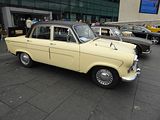


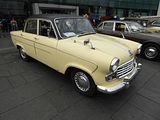
TRIUMPH
The Triumph Cycle Company began as cycle manufacturers at Much Park Street, Coventry in 1889. Yet the origins began in London four years earlier when Germans, Siegfried Bettmann (1863-1951) and Mauritz Schulte (b.1858) began selling British built cycles abroad under the ‘Triumph’ name. After some early developmental work, it was in 1902 that Triumph marketed their first motorcycles at new works at Priory Street, Coventry. It was through the manufacture of motorcycles that was to make Triumph a household name. During the First World War, the company secured a deal supplying some 30,000 models for active war service, and these were soon labelled ‘Trusty Triumph’s’ by the soldiers that used them. Production continued with great confidence into the 1920s, but by the beginning of the 1930s, the business, like many others, fell on hard times and almost collapsed entirely. Up stepped Jack Sangster of the Ariel Company to take control, and before long he drafted in a number of personnel who would alter the company’s fortunes, most notably that of Edward Turner. In 1937 Turner unveiled the 500cc ‘Speed Twin’, a machine that revolutionised the motorcycle world through its design. In November 1940, the Coventry factory was all but destroyed by German bombers, but production recommenced at a new site at Meriden and remained so for a further 40 years creating iconic machines such as the ‘Tiger’ range, and the ‘Bonneville’. Triumph motorcycles are still being made to this day at Hinckley.
Considering that motorcycle production began at Triumph in 1902, it is quite surprising that the production of cars did not come about until 1923 with the 10/20 two-seater, as many other motorcycle manufacturers had diversified far more quickly. The 10/20 model was a clear response to the Austin Seven, launched the previous year. As production volumes of cars increased quickly in the 1920s, so models had to change and prices came down. Triumph were no exception, and by 1927 their product was called the Super Seven, an even clearer reference to what they thought was the principal competitor. Whereas the Austin was now being sold for £100, the Triumph was noticeably more expensive at £130, so sales never really challenged the Longbridge offering. That caused Triumph to come up with a new strategy, offering larger and more costly cars, and the result of this was the 1933 Gloria and later Dolomite. Nice though these models were, this policy did not work, either, and Triumph was absorbed into the Standard Motor Company. After the war, it was as if the new company did not know which brand to use, with some models alternating between Triumph and Standard, before finally settling on the former for all new cars from the 1959 Herald, phasing out the Standard name with the end of production of the Vanguard and Ensign in 1963. During the 1960s and 1970s, Triumph, now part of the BMC Group, produced a range of sports cars (the Spitfire based models and the TR series) as well as saloons and estates that combined both a sporting and luxury touch. Truly this was the heyday for the marque, but starved of investment, when the replacement for the big 2000/2500 cars was chosen to be a Rover, it was clear the marques days were numbered, something that the last model to bear the Triumph name, the 1981 ‘Acclaim’ could not delay, as it, too, was replaced by a Rover badged car.
Rather surprisingly, the only Triumph that I saw at the event was a Gloria. I gather that there had been plenty of other Triumph models at other venues during the day, and was sorry to miss them, as this is one of my favourite brands from British motoring history. Launched in 1934, there was a large and complex range of Gloria sporting saloons, coupés, tourers, 2-seater sports cars, drophead coupés and golfer’s coupés. All these Glorias, apart from the final two models, the 1.5 litre Saloon and Fourteen (1767 cc) Six-Light Saloon of 1937-1938 were powered by 1087 or 1232 cc four-cylinder or 1467 or 1991 cc six-cylinder Coventry Climax overhead inlet and side exhaust valve designed engines modified and built under licence by Triumph. The chassis came in two lengths, with an extra 8 in ahead of the passenger compartment depending on whether the four- or six-cylinder engine was fitted, and had conventional non-independent suspension with semi elliptic leaf springs. The brakes were hydraulically operated using the Lockheed system with large 12 in drums. A four-speed transmission was fitted with an optional free wheel mechanism allowing “clutchless” gear changing. Synchromesh was fitted to the gearbox on the final Fourteen and 1.5-litre models. From August 1934 to 1936 the Gloria range included ‘Gloria Vitesse’ models (not to be confused with later Vitesses) which were up-rated, with twin carburettor engine and equipment, versions of the equivalent Gloria and slightly different bodywork in the case of some saloons. From 1934 to 1937, there was also an open two-seat sporting model, the Southern Cross, re-using the name previously applied to the sports version of the Triumph Super 9. This used a shortened chassis of 96 in for 1232 cc four-cylinder models and 104 in for the 1991 sixes. The car seen here is a 1935 Southern Cross with the 4 cylinder engine.
AND FINALLY
When I walked back around the corner to the car park, among all the modern machines, I came across this Mark 2 Granada Ghia X 2.8 Estate. Once a common sight, these would have appealed to the sort of person who these days probably has a BMW, and probably an X3 or X5 at that! The Ghia X was a luxurious top of the range model added towards the end of production, at which point the conventional Saloon and Estate models were replaced by a more aerodynamic looking Hatch model.
This was an interesting little event. Clearly if I had read the publicity material more carefully, I would found the rest of the cars in the other locations which I did not visit, but that small oversight does not detract from the fact that this was an enjoyable afternoon, with a very varied collection of cars to see, learn about and to talk to some owners and fellow enthusiasts. Whilst the Coventry Motoring Festival may be no more, there Museum does still organise a number of other events literally on the own door step in Millennium Place, and on the evidence of the couple I have attended in recent weeks, these are well worth seeking out.

